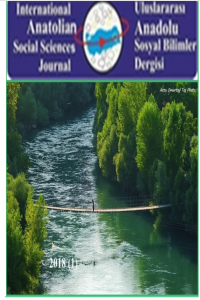DESTİNASYON PAZARLAMA ARACI OLARAK GASTRONOMİ TURİZMİ: BİR LİTERATÜR İNCELEMESİ
Destinasyon, Destinasyon Pazarlaması, Gastronomi, Gastronomi Turizmi
GASTRONOMY TOURISM AS A DESTINATION MARKETING TOOL: A LITERATURE REVIEW
Destination, Destination Marketing, Gastronomy, Gastronomy Tourism,
___
- Bahar, O., & Kozak, M. (2005). Küreselleşme Sürecinde Uluslararası Turizm ve Rekabet Edebilirlik. Ankara: Detay Yayıncılık.
- Birdir, K., & Akgöl, Y. (2015). Gastronomi turizmi ve Türkiye’yi ziyaret eden yabancı turistlerin gastronomi deneyimlerinin değerlendirilmesi. İşletme ve İktisat Çalışmaları Dergisi, 3(2), 57-68.
- Buhalis, D. (2000). Marketing the Competitive Destination of the Future. Tourism Management, 21, 97-116.
- Cesur, Z. (2020). Destinasyon pazarlaması kapsamında destinasyon aidiyeti kavramının incelenmesi. Balkan ve Yakın Doğu Sosyal Bilimler Dergisi, 6, 101-107.
- Coltman, M. M. (1989). Tourism Marketing. New York: Van Nostrand Reinhold.
- Cooper, C., Fletcher, J., Gilbert, D., Shepherd, R., Wanhill, S. (1998). Tourism: Principles and Practices, 2nd ed, Addison Wesley Longman, England.
- Correia, A., Moital, M., Da Costa, C. F., & Peres, R. (2008). The determinants of gastronomic tourists' satisfaction: a second‐order factor analysis. Journal of foodservice, 19(3), 164-176.
- Crouch, G.I., & Ritchie, J.R.B. (1999), Tourism, Competitiveness and Societal Prosperity, Journal Of Business Research, 44(3), 137-152.
- Du Rand, G. E., Heath, E., & Alberts, N. (2003). “The Role of Local and Regional Food in Destination Marketing: A South African Situation Analysis”, Journal of Travel and Tourism Marketing, 14(3/4), 97–112.
- Gheorghe G., Tudorache P., Nistoreanu P. (2014). Gastronomic Tourism, A New Trend for Contemporary Tourism. Cactus Tourism Journal, 9(1):12-21.
- Gillespie, C., & Cousins, J. A. (2001). European gastronomy into the 21st century. Routledge.
- Gökdeniz, A., Erdem, B., Dinç, Y., Uğuz, S.Ç. (2015). Gastronomi Turizmi: Ayvalık’ta Yerli Turistler Üzerinde Görgül Bir Araştırma. Journal of Tourism and Gastronomy Studies, 3(1): 14-29.
- Gövce, Ö. G. M., Özdoğan, O. N., & Şimşek, Ö. G. O. U. (2018). Destinasyon Pazarlamasında Gastronominin Rolü: Bibliyometrik Bir Analiz.
- Guzman, L.T. & Canizares, S.S. (2011). “Gastronomy Tourism and Destination Differentiation: A Case Study in Spain”, Review of Economics & Finance, September.
- Gyimothy, S., Rassing, C. & Wanhill, S. (2000). Marketing Works: A Study of Restaurants on Bornholm, Denmark. International Journal of Contemporary Hospitality Management, (12): 371 – 379.
- Harrington, R. J., & Ottenbacher, M. C. (2010). Culinary tourism. A case study of the gastronomic capital. Journal of Culinary Science & Technology, 8(1), 14-32.
- Hashimoto, A., & Telfer, D. J. (2006). “Selling Canadian Culinary Tourism: Branding the Global and the Regional Product”, Tourism Geographies, 8(1), 31–55.
- Horng, J. S., & Tsai, C. T. S. (2010). “Government Websites For Promoting East Asian Culinary Tourism: A Cross-National Analysis”, Tourism Management, 31(1), 74-85.
- Hosany, S., Ekinci, Y., & Uysal, M. (2006). Destination Image and Destination Personality: An Application of Branding Theories to Tourism Places. Journal of Business Research, 59, 638-642.
- Hsua, H. S., Wolfe, K. ve Kang, S. K. (2004). “Image Assessment for a Destination with Limited Comparative Advantages”, Tourism Management, C. 28, S. 1, ss. 121-126.
- Hu, Y. and B. J. R. Ritchie (1993)., Measuring Destination Attractiveness: A Contextual Approach, Journal of Travel Research’ 32 (2): 25-34.
- Ignatov, E., & Smith, S. (2006). Segmenting Canadian culinary tourists. Current issues in tourism, 9(3), 235.
- Indra, F., Juliana, J., Hubner, I., & Sitorus, N. B. (2022). Development Of Gastronomic Tourism Potential In Pontianak West Kalimantan. Journal of Information Systems and Management (JISMA), 1(5), 28-42.
- Jovicic, D. (2016). Cultural tourism in the context of relations between mass and alternative tourism. Current Issues in Tourism, 19(6), 605-612.
- Kırca, M. (2014). Destinasyon ve Destinasyon ile İlgili Kavramlar. http://www.mustafakirca.com/destinasyon-ve-destinasyon-ile-ilgili-kavramlar.html (Erişim Tarihi: 25 Mart 2023)
- Küçükkömürler, S., Şırvan, N. B., & Sezgin, A. C. (2018). Dünyada ve Türkiye’de gastronomi turizmi. Uluslararası Turizm Ekonomi ve İşletme Bilimleri Dergisi, 2(2), 78-85.
- Leiper, N., (1995), Tourism Management, RMIT Press, Melbourne
- Lin, Y. C., Pearson, T. E., & Cai, L. A. (2011). Food as a form of destination identity: A tourism destination brand perspective. Tourism and Hospitality Research, 11(1), 30-48.
- Line, N. ve Wang, Y. (2017). A Multi-Stakeholder Market Oriented Approach to Destination Marketing, Journal of Destination Marketing & Management, 6(1), 84-93.
- Mankan, E. (2017). Destinasyon pazarlamasında çekici bir faktör olarak Türkiye’deki gastronomi müzeleri örneği. Turkish Studies, 14(2), 641-654.
- Moira, P., Mylonopoulos, D. ve Kontoudaki, A. (2015). Gastronomy as a form of cultural tourism a Greek typology, Tims.Acta: Naučni Časopis Za Sport, Turuzam İvelnes, 9, 135-148.
- Okumus, B., Okumus, F., & McKercher, B. (2007). “Incorporating Local and International Cuisines in The Marketing of Tourism Destinations: The Cases of Hong Kong and Turkey.”, Tourism Management, 28(1), 253–261.
- Başlangıç: 2017
- Yayıncı: Yusuf ARSLAN
MEHMET ÂKİF’İN UFKU: BATI’NIN DOĞU POLİTİKASINA ERKEN BİR BAKIŞ
Z KUŞAĞININ ÇALIŞMA DEĞERLERİNİN DELPHİ METODU İLE BELİRLENMESİ
ZİHİN KURAMI GÖREV BATARYASI (TOMTB) ’NIN 3-5 YAŞ ÇOCUKLARI İÇİN GEÇERLİK VE GÜVENİRLİK ÇALIŞMASI
Canan KELEŞ ERTÜRK, Kezban TEPELİ
MÜELLİFİ BİLİNMEYEN MANZUM BİR SÂ’ATNÂME: ESRÂR-I EYYÂM
Berivan CAN EMMEZ, Zahir SÜSLÜ
ÜNİVERSİTE ÖĞRENCİLERİNDE SOSYAL MEDYA BAĞIMLILIĞININ SOSYAL DIŞLANMA İLE İLİŞKİSİ
İLKÖĞRETİM YÖNETİCİLERİNİN ÖZ-YETERLİK DÜZEYLERİ İLE OKUL LİDERLİK UYGULAMALARININ DEĞERLENDİRİLMESİ
Serdal IŞIKTAŞ, Kübra ÖZSAT, Hülya ŞENOL, Recep ABAKAN
Canan KELEŞ ERTÜRK, Kezban TEPELİ
BAĞLANMA KURAMI VE SOSYAL HİZMET
